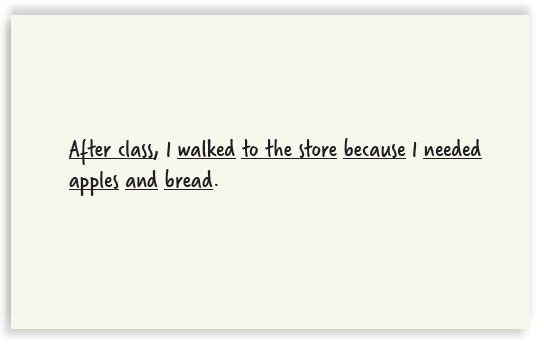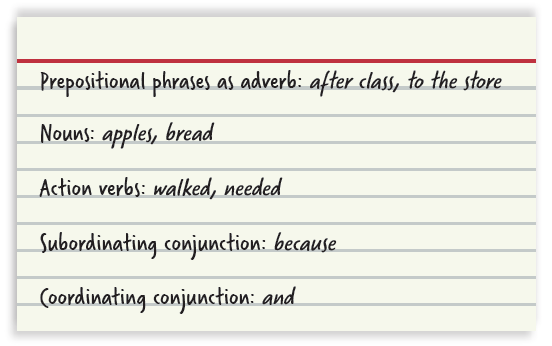Project Assignment
Goal
In Chapter 2, you learned how to identify clauses and sentence patterns and how to revise
fragments, fused sentences, and comma splices. You will demonstrate your understanding
of these concepts by revising four paragraphs, each of which has a unique issue to address.
Directions
Part 1
In the Materials section, read each paragraph one at a time, along with the directions for
how to revise it. Choose at least three paragraphs to rewrite.
Part 2
Copy and paste or rewrite your chosen paragraphs from scratch to make the necessary
revisions. Keep in mind that there is no single "correct" way to revise each paragraph.
Materials
Paragraph 1
This paragraph is one long fused sentence. Split it into multiple complete sentences.
Remember to add punctuation and update capitalization.
Many writers prefer to write alone however, joining a writing community can benefit
writers in ways that solitary writing cannot writers are often shy about sharing their writing,
not because they are writing about personal topics but because they struggle to separate
their writing from their personal identities it's important to remember that criticism and
feedback about a piece of writing is not criticism of the writer's personality, intelligence, or
value when writers share their work with each other at various stages of the process, they
can perceive the quality of their writing more clearly and learn to accept feedback without
feeling hurt or personally scrutinized.
Paragraph 2
This paragraph only uses simple sentences. Combine the sentences using the following patterns and parts of speech:
-
Compound sentences
-
Complex sentences
-
Relative clauses
-
Prepositional phrases
-
Conjunctive adverbs
First drafts can be frustrating. Many writers do not look forward to them. It is common to focus on correctness. Experienced writers know a first draft will not be perfect. First drafts have grammar or punctuation errors. It's okay to make many mistakes in a first draft. The ideas are more important. A messy first draft might be more useful. It allows room for growth. A draft with perfect grammar and weak content is not useful. Writing a first draft is an opportunity to experiment. It's a safe place to take risks.
Paragraph 3
This paragraph uses nouns repetitively. Replace nouns with pronouns, remembering to use
pronoun-antecedent agreement and clear pronoun reference.
Twyla has been working on Twyla's sociology essay for the past two weeks. When
Twyla first began, Twyla knew Twyla needed to focus on the key ideas Twyla wanted to
communicate to Twyla's audience. Twyla knew Twyla's audience would be interested in
an essay that connected directly to Twyla's audience's lives instead of one that discussed
abstract concepts. By the time Twyla was working on the second draft of Twyla's essay,
Twyla realized the essay's focus was too broad and that the focus would need to be
narrowed if Twyla was going to address Twyla's audience's personal concerns. When Twyla
finished the final draft, Twyla finally took the time to address grammatical errors. Twyla
knew Twyla didn't need to focus on the grammatical errors earlier in the writing process,
when the grammatical errors would have distracted Twyla from the focus of Twyla's essay.
Paragraph 4
This paragraph contains both complete and incomplete sentences. Identify and revise the
fragments, fused sentences, and comma splices.
Talented, professional writers who appear to write effortlessly. However, they make
many errors in the first several drafts, they also know they need to trust the writing process.
To trust the process that the writing will improve until it has achieved a certain level of
quality. Each stage of the writing process. Which focuses on a different objective. Allows
the writer to develop their thoughts without the burden of writing well. Great writers aren't
people who can write without making errors they are people who that perfect first drafts
don't exist. And that the best writing has been through every stage of the writing process.
Materials
Word processing program or pen/paper
Checklist
Writing Assignment
Goal
The goal of this writing assignment is to apply your knowledge of clauses, sentence
patterns, agreement, and reference to writing a review of a book, movie, or place/activity
(such as a theme park, restaurant, museum, etc.).
Directions
Part 1
Select a book, movie, or place/activity to review. Choose something that you know well
enough to discuss confidently and in detail.
Part 2
Choose three aspects of your topic that you consider to be strengths or weaknesses. If you
prefer, you can write about two strengths and one weakness or two weaknesses and one
strength. See the Materials section for more guidance on each topic (book, movie, or place).
Part 3
Choose one of these purposes for your writing.
-
Persuade your audience to read the book, watch the movie, or visit the place.
-
Persuade your audience to avoid the book, movie, or place.
-
Without recommending a specific action, invite your audience to draw their own
conclusions about the topic based on the information you provide.
Part 4
Write your review with the purpose in mind. Include an introduction, three body
paragraphs (one for each strength or weakness), and a conclusion paragraph, for a total
of five paragraphs.
In the introduction, write a short explanation of what the book or movie is about. If you
are writing about a place, explain the location and theme. Then, state the purpose for
your review.
In each body paragraph, start with a strong claim about the strength or weakness you're
going to discuss. Explain why this topic is worth discussing. Include specific examples
from the book, movie, or place of its strength/weakness.
In the conclusion, restate your purpose. Review the three strengths or weaknesses you
discussed. Finally, state why your audience should or should not read this book, see this
movie, or visit this place.
Materials
Word processing program or pen/paper
Browser/search engine
Book
Make sure you have access to a copy of the book or a detailed summary for reference.
Some strengths/weaknesses could include but are not limited to the following:
-
How is the plot structured? Is it interesting?
-
Do you have a strong reaction to a specific event or moment?
-
Are the characters interesting? Are they realistic?
-
Is there a clear message?
-
Is the ending satisfying and/or believable?
Movie
Make sure you have access to the movie or a detailed summary for reference.
Some strengths/weaknesses could include but are not limited to the following:
-
Does the movie keep you engaged from beginning to end?
-
Is the acting believable?
-
Does the soundtrack contribute to the story?
-
How do camera angles, lighting, or colors affect the story?
-
Are the special effects believable and realistic?
-
Do you have a strong reaction to a specific scene?
Place/Activity
If possible, look up the place or activity online so that you can review details and key
information. If you have photos or mementos, use them to remember your experience.
Some strengths/weaknesses could include but are not limited to the following:
-
Is the place easy to navigate?
-
Is there a variety of options for all age levels and interests?
-
Is it a cost-effective experience? Is it meant to be one?
-
How effective are the decorations, landscaping, and colors?
-
Which attractions or elements are the best, and why?
-
Which food options are the best, and why?
Checklist

